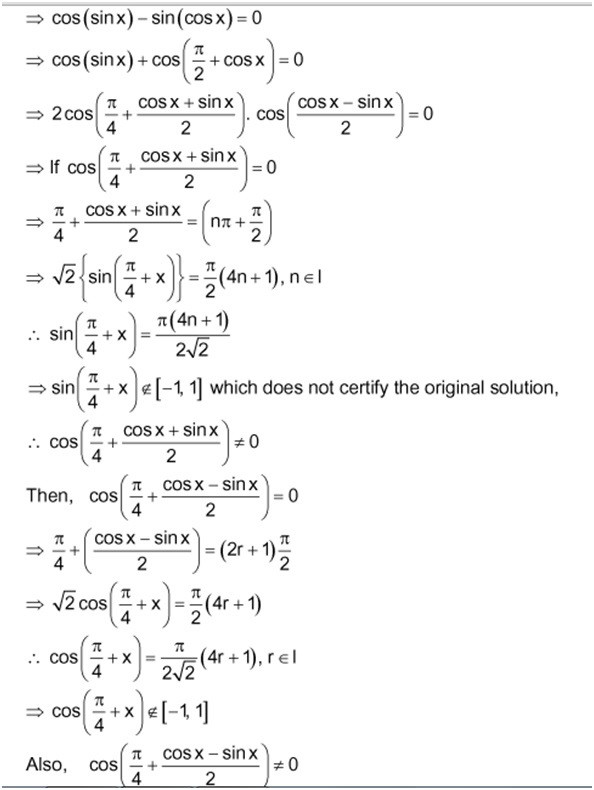Needed a short method
Prove that has no real solution.
The method i came across was this

LHS is not equal to RHS.
If u have got any other method do post it.
No vote yet
1 vote
Easy Math Editor
This discussion board is a place to discuss our Daily Challenges and the math and science related to those challenges. Explanations are more than just a solution — they should explain the steps and thinking strategies that you used to obtain the solution. Comments should further the discussion of math and science.
When posting on Brilliant:
*italics*or_italics_**bold**or__bold__paragraph 1
paragraph 2
[example link](https://brilliant.org)> This is a quote# I indented these lines # 4 spaces, and now they show # up as a code block. print "hello world"\(...\)or\[...\]to ensure proper formatting.2 \times 32^{34}a_{i-1}\frac{2}{3}\sqrt{2}\sum_{i=1}^3\sin \theta\boxed{123}Comments
Look at the function f(x)=cos(sin(x))−sin(cos(x)). This function is even and periodic with period 2π. so we just need to focus on the interval [0,π].
Now f(0)=1>0. Also, for x∈[2π,π] we have cos(sin(x))>0 and sin(cos(x))≤0, so f(x)>0 on this interval.
So we now just need to focus on the interval (0,2π). On this interval we have that both cos(x) and sin(x) lie between 0 and 1, for which sin(cos(x))<cos(x)<cos(sin(x)),, i.e., f(x)>0. Thus f(x)>0 for all x.
(To expand on this last step, note that for θ in (0,2π) we have 0<sin(θ)<θ, and so cos(sin(θ))>cos(θ). )
Log in to reply
Yes! I recall when I first saw bounding those values by cosx, which seemed really ingenious to me.
The easiest way for me is to plot the graph for the full range of x∈[0,2π). The graph is as follows. We note that the sin(cosx)=cos(sinx) always.
Log in to reply
Well, part of the question would then be "How do you know that's how the graphs should be drawn (Other than relying on a calculator / graphing capabilities)?"
Log in to reply
Do you mean how to do graphs with Excel spreadsheet? If so, maybe I should write a wiki on it. There are others requested for it. I just don't like to do it.
It is easy to see that cos(cos(x))−sin(sin(x))=0 has no solutions. Just replace x with 2π−x
Log in to reply
@Brian Charlesworth @Tanishq Varshney
It's convincing that cos(cos(x))=sin(sin(x)) but how can you prove that statement?
Sketch the rough graph of both the functions